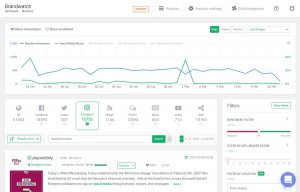— January 31, 2019
It’s happened to all of us – your computer crashes just before you save the report you’ve been finishing all afternoon or the printer jams while you’re printing that big proposal.
Anger, frustration, helplessness, and a touch of nausea are the result. These are the absolute worst feelings employees could have on the job, and the more frequently they feel them, the more likely you are to lose your top talent.
Cost is often a big reason cited by business owners for not upgrading or advancing technology, but the truth is that fast computers, high-speed internet, accessible data backups, and secure electronic files are not luxury items. They are essential tools to most effectively utilize and retain your greatest asset and most limited resource – your most talented employees.
According to the 2018 Global Talent Trends study by Mercer, “as [employees] support technology, they want technology to support them back – through state-of-the-art platforms that enable people to connect, collaborate, and innovate together.”
Employees want to use critical thinking and creativity on the job.
Good employees are frustrated by redundant tasks and activities that could be easily automated. They want to work on challenging projects that allow them to stretch their critical thinking and creativity in the workplace. While there is an ongoing debate about how automation and artificial intelligence will impact jobs, the reality is that jobs have already been drastically changed by technology and automation. Humans no longer need to do mindless, repetitive, unfulfilling work; and employers can utilize technology to maximize the unique skills, talent, and creativity that their employees bring to the table. However, when technology isn’t working for those most talented employees, they begin to feel unfulfilled by redundancy and inefficiency and will begin to look for opportunities elsewhere that better utilize their unique skills and talents.
The technology necessary to keep your employees feeling satisfied and productive varies based on your business and specific job functions, but here are some things to consider as you develop a technology strategy designed to maximize your human capital:
- What is the expected lifecycle of each piece of equipment in my company, and what machines are approaching and/or are beyond their expiration date?
Older equipment runs slower and is more likely to be incompatible with software updates, both of which leads to user frustration and loss of productivity. On average, computers and servers have an expected lifespan of about 3-5 years, with a huge variance depending on use, maintenance, and storage conditions. Depending on the user’s needs, the lifespan could be extended by expanding memory and replacing parts over time or could be shortened by poor ventilation and heat exposure. A sound technology strategy should include an inventory and lifecycle management plan for all devices, allowing you to plan for routine maintenance, upgrades, and replacements. Today’s technology is designed to be used and not owned. Lease and rental programs are great options to eliminate lump-sum investments in equipment.
- What is the health and performance level of each piece of equipment in my company, and how is that monitored?
Equipment age is just one element of hardware performance. Newer equipment can cause the same levels of user frustration and loss of productivity due to low disk space, high CPU, low memory, or decreased bandwidth. Many of these issues can be addressed through troubleshooting and maintenance, but equipment must be regularly monitored in order to appropriately manage performance, and in some cases identify when a user’s computing needs have changed and requires equipment with increased capacity. For these reasons a network monitoring system is essential to your technology strategy.
Employees want the flexibility to work when and where they are most productive.
For today’s workforce, work-life balance has become work-life integration. While not feasible for all businesses, flexible schedules and work from home options give many employers a greater pool of candidates from which to recruit talent not limited by geographic location. Additionally, many employees are most creative outside of traditional work hours and expect to be able to work from their bed when they wake up at 3 a.m. with their next big idea.
Flexible schedules and remote work options can be excellent employee retention and recruitment tools but rely heavily on sound technology infrastructure and strategy to work for both you and your team. Here are a few things to consider in a technology strategy that accommodates remote workers:
- What equipment will remote employees use to work remotely and how will I navigate security across a mobile workforce?
Many employers have a Bring Your Own Device (BYOD) policy to allow remote workers to utilize their own equipment to work from home. However, security concerns and employee privacy make BYOD policies more difficult and at times costlier than providing company-issued equipment. While a remote workforce may offer cost savings in physical space and furniture, a sound technology strategy will identify increased communication tools and security infrastructure necessary for maintaining productivity and engagement among remote workers.
- How will remote workers access the company network?
There are many ways employees can access the files and systems they need when working remotely. The best solution for your company and its different types of workers will vary based on their individual needs. For example, some employees may only need to log into cloud-based systems when working in the field, while others may need to access company files including sensitive data and personal information. Additionally, different industries may have different security requirements for accessing certain types of information. For example, the Health Insurance Portability and Accountability Act (HIPAA), defines specific requirements for ways in which covered entities access Protected Health Information (PHI).
A secure VPN accessed through company-owned and monitored devices is the most secure way for remote workers to access company data. However, your technology strategy should include a more in-depth analysis of specific requirements for remote workers within your specific business and industry.
Employees expect you to earn their trust.
Employees trust their employers with a lot of sensitive information. A poor technology strategy can result in lost documents, corrupt files, and computers slowed down by malware. This makes day-to-day work more difficult and frustrating for employees, but also creates a lack of trust in your company. When employees lack trust in the company they become less motivated to encourage customers to share information that could be vital to the product or service you provide. Additionally, they may question your ability to keep their employee information safe which could result in legal consequences for your business. Finally, if your company administers a self-funded group health plan, there are even stricter compliance concerns associated with the Health Insurance Portability and Accountability Act (HIPAA).
Specific network security and disaster recovery requirements vary by business and industry, but any sound technology strategy should evaluate and plan for the following items:
- What data security compliance regulations apply to my business?
The alphabet soup of security compliance regulations – GDPR, HIPAA, PCI DSS 3.2.1, FERPA, GLBA, SOX, FISMA, etc. If you’re not well-versed in cybersecurity practices – and most business owners outside of the tech industry are not – it is imperative that you enlist the help of a trusted resource to help you navigate the compliance regulations and standards applicable to your business or industry. Aside from the fact that protecting sensitive information is the right thing to do, in certain industries, the legal implications can be devastating to both your business and you personally. Most small businesses are unable to recover after a cyber-attack; and HIPAA violations, for example, can result in civil penalties to the business owner and individual employees. Your technology strategy should include a data security plan based on both legal requirements and best practices.
- What is my backup strategy, disaster recovery plan, and the associated cost of retrieval?
Your data backup strategy should be part of your greater disaster recovery plan but also protects your data from simple mistakes and human error (i.e. accidentally deleting a file or changing a document). Backup strategies vary in frequency, method, medium, and location. Your technology strategy should include an evaluation of the impact data loss would have on your business, and for how long your business could survive without critical data. This will help you identify a solution that fits the risk of loss your business can tolerate. Typically, the best practice in small businesses includes a combination of a local backup appliance, paired with a redundant, bi-coastal cloud backup solution. Additionally, you should confirm that all backup data is stored under the same level of security as your original data.
Technology strategy is an employee retention strategy.
A sound technology strategy allows you to provide employees with the tools they need to feel fulfilled and challenged in their job, work where and how they prefer and have confidence and trust in your organization. These are key elements to employee satisfaction and contribute to the overall retention of your most talented team members.
While most small businesses may not have the internal resources and expertise to develop and implement a technology strategy, any external IT partner you choose to work with should have a strong understanding of the business implications of technology. Be sure your partners are experienced and comfortable addressing these strategic initiatives in your industry.
This post was originally published here.
Business & Finance Articles on Business 2 Community
(63)
Report Post


